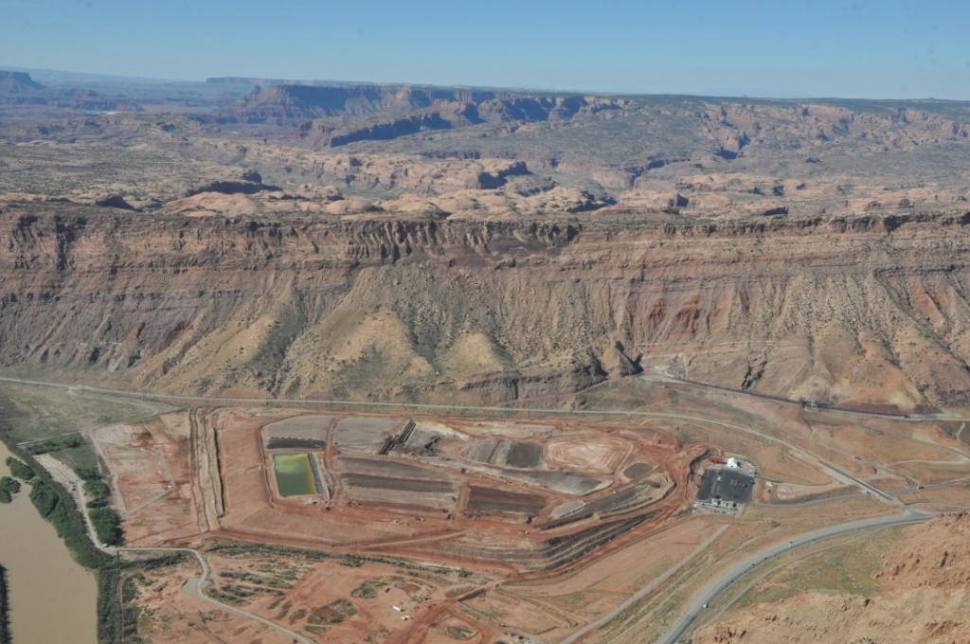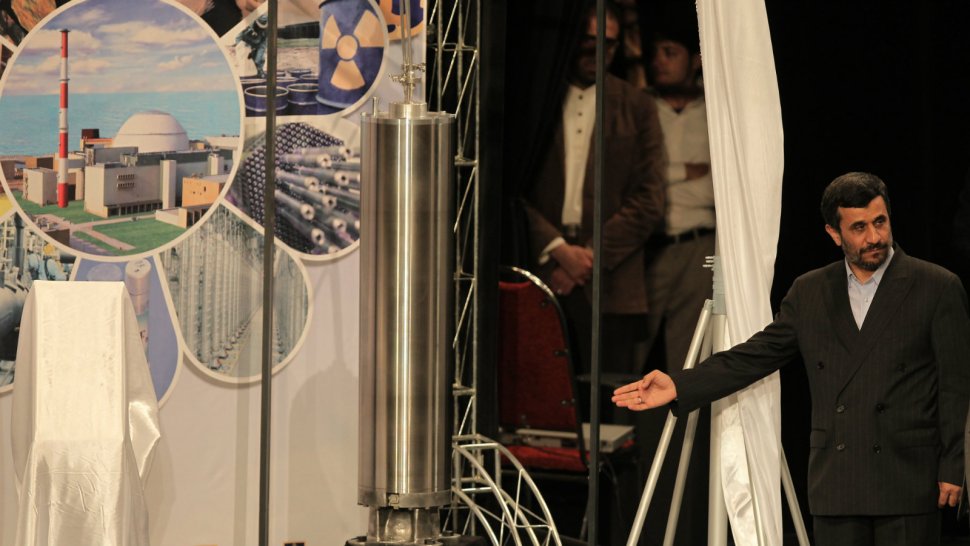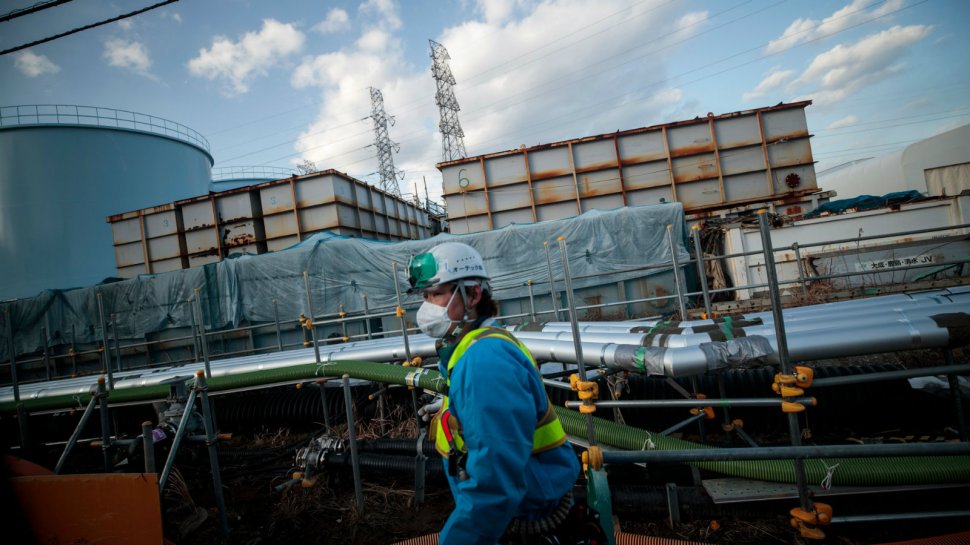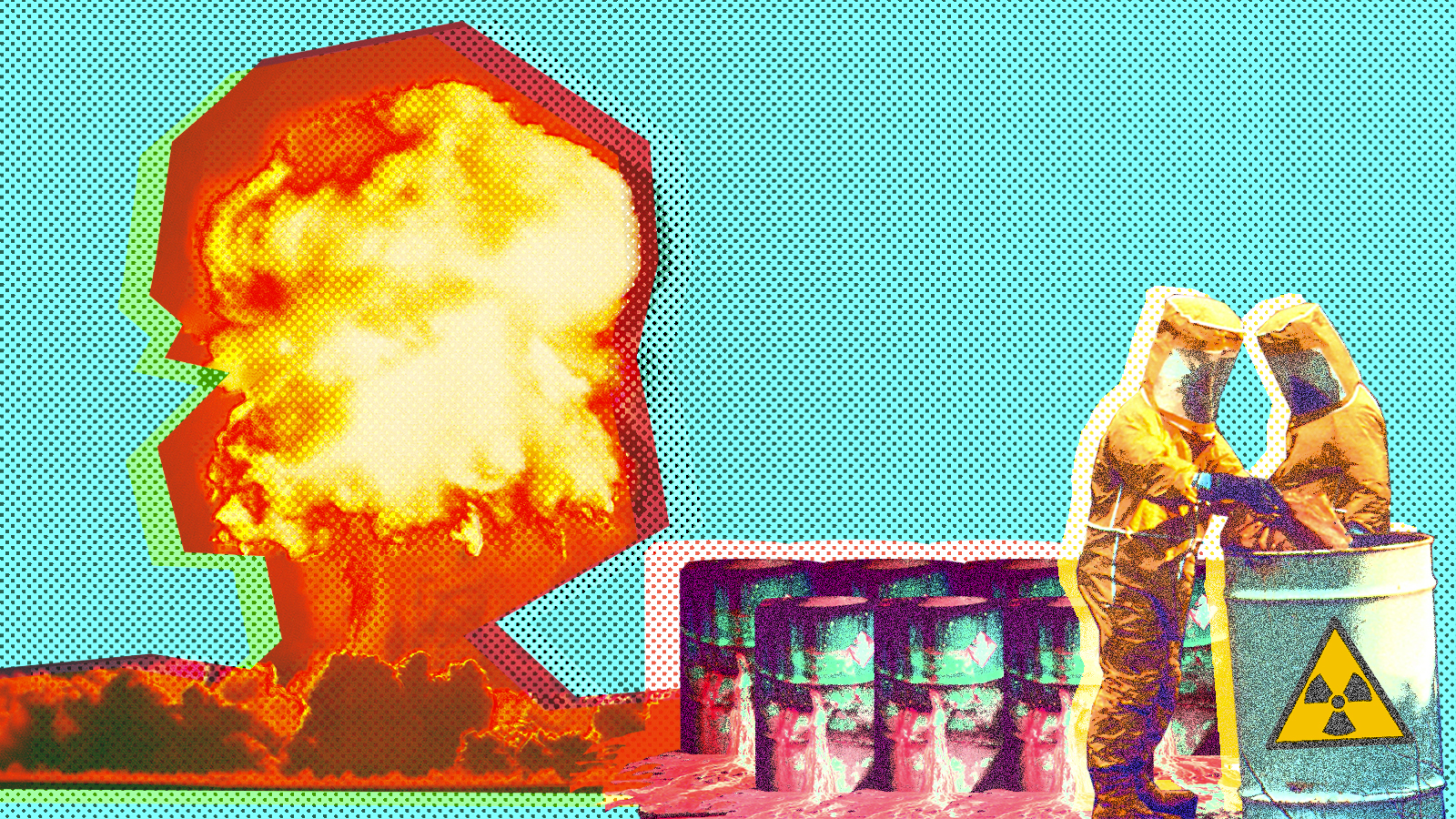Is it any wonder that nuclear power scares people? The word nuclear alone conjures up a parade of terrors: the sinister radiation, the whiff of apocalypse, and the tendency to go boom.
Those are the obvious sci-fi horrors. But there are plenty of other risks of nuclear power that aren’t so obvious: the hazards of uranium mining, the fouled water, and the radioactive waste.
So do these horrors mean nuclear power shouldn’t be part of our tool kit for fighting climate change? After all, it doesn’t produce greenhouse gases. That’s why some have pushed to keep existing nuclear power plants open, and even build more. Often, nuclear nightmares are considered in isolation rather than weighed against the alternatives. Nobody, for instance, wants to get stuck with nuclear waste that stays radioactive for 10,000 years — but perhaps some would prefer that to coal waste, which contains mercury and lead and remains toxic forever.
The risks of nuclear power appear right from the beginning of the process with uranium mining. And they continue to pop up throughout the nuclear life cycle, from enrichment and reactor operation to the radioactive waste at the end. It’s a process fraught with hazards.
Mining
When I started asking around about reasons to oppose nuclear power, I was surprised by how the history of uranium mining kept coming up. There’s a reason for this: It’s appalling.
The writer Peter Hessler visited the uranium towns of Utah and Colorado and met men breathing through oxygen respirators and women who had buried miners after they suffered agonizing deaths. One described her uncle’s decline to Hessler: “His lungs just crystallized and he was spitting up this bloody stuff. They told us it was parts of his lungs.”
During World War II, the U.S. government began digging for uranium throughout the Southwest to create the first atomic bombs. Officials saw early on that the work posed a hazard, says Stephanie Malin, a sociologist at Colorado State University, but they didn’t tell the miners or the people living in the surrounding communities. After all, they were making a secret weapon.
“They made recommendations — better ventilation in the mines, radiation monitors,” Malin says. “But these recommendations were made in classified public health documents in the 1950s. The government responded by not doing anything until the 1970s.”

Crushed rock from a uranium mill in Moab, Utah. U.S. Department of Energy
Meanwhile, people living downstream drank water seeping out of the mines, full of radioactive isotopes. Cancer clusters began to emerge, Malin tells me.
Many uranium mines were on the Navajo Nation, a 27,000-square-mile territory in northern Arizona and New Mexico. And this isn’t just ancient history.
“An undetermined amount of uranium mines still exist on native lands, and the government hasn’t finished cleaning up the ones we know about,” says Cecilia Martinez, executive director of the environmental justice group, Center for Earth, Energy, and Democracy.
The federal government has fairly sophisticated clean-up plans, but politicians have refused to provide the money needed to carry them out, says Cindy Vestergaard, who studies the uranium supply chain at the Stimson Center, a nonpartisan think tank.
Mining today is much safer than it was during the Cold War, Vestergaard says. It takes at least a decade to complete all the environmental- and social-impact assessments needed before you start a new mine. “One thing I can say about mining is that it’s radically different than it was in the ‘50s and ‘60s,” Vestergaard says.
So mining’s much safer, but that’s not the same as safe. Studies have found increased risks ranging from lung cancer to diabetes in communities near uranium mines (though there’s not enough evidence to prove that mining is the cause). Other studies have suggested that modern-day miners are more likely to get sick than white-collar workers.
Mining of all kinds scars the land and puts people in danger. Coal and tar sands mining cause the same problems on a larger scale. Even renewable power relies on people unearthing the cobalt, indium, and other materials for solar panels and batteries.
There are bits of radioactive material scattered throughout the earth’s crust, and when you excavate tons and tons of rock, you’re going to get exposed to a lot of it. As a result, the people digging up the elements required to make solar panels collectively get a little more radiation than the people mining an equivalent amount of uranium. Blasting out the iron ore needed to build wind turbines and generate the same amount of power exposes miners to a little less radiation.
Whether any of this radiation is harmful depends on how it’s spread around. The earth, bananas, and airplane trips give us small, harmless doses of radiation all the time. But a giant dose can kill. A United Nations report found that individual uranium miners are exposed to roughly 4 percent of the federal limit of radiation for x-ray technicians and other workers who deal with radiation.
Risks of Nuclear … war?
After uranium ore is milled into yellow cake, it goes through an enrichment process where centrifuges spin uranium to transform it into nuclear fuel. Keep that fuel spinning longer, and it eventually turns into the stuff that can level cities.
So you can’t separate nuclear power from nuclear war. The crucial link in this connection between energy and weaponry is the enrichment process, not the reactors. You can’t build a warhead with nuclear-reactor fuel. You need to enrich it further. So as long as new reactors get their fuel from existing enrichment facilities, it doesn’t increase the risk of nuclear proliferation, says Matthew Bunn, a nuclear policy analyst at Harvard.
“As long as we keep control of enrichment and reprocessing, nuclear power can spread without spreading nuclear weapons,” Bunn explains.
There’s no guarantee that the United States and its allies will be able to keep control of the technology needed to concoct weapons-grade uranium. Saudi Arabia, for instance, is trying to make a deal to have the United States, Russia, or China build it a nuclear power plant. But Saudi Arabia refuses to say that it won’t then build the infrastructure needed to create nukes.
Sometimes, governments say they want to develop enrichment technology to generate their own fuel when they actually want to start making warheads. Iran, for instance, has insisted that it’s only enriching uranium for reactors, but the fact that it built a secret enrichment plant — and says it could produce weapons-grade uranium within a week — suggests that something else is up.

Former Iranian President Mahmoud Ahmadinejad unveils a sample of the third generation centrifuge for uranium enrichment in 2010. BEHROUZ MEHRI/AFP/Getty Images
You don’t need weapons-grade fuel to cause a disaster. Nuclear experts also stress over the possibility of a terrorist attack. In 1982, after training for 10 years, an anti-nuclear activist named Chaim Nissim shot five rocket-propelled grenades at the Superphénix nuclear plant on the Rhone River in France. The reactor was still under construction, so there was no danger of a meltdown. The grenades damaged the outer concrete shell but not much else.
Nuclear experts are sure that terrorists have considered attacking working plants with the aim of causing a meltdown. So facilities need security: guns, guards, and gates.
“You need to make sure you have enough security that so bad guys don’t do what the tsunami did to Fukushima — cutting off the power and disabling the backup power to start a meltdown,” Bunn says. Most nuclear plants have so much security that terrorists look elsewhere, “at a dam or a chemical plant instead,” he says.
It appears to be working so far. There hasn’t been an attack on a civilian reactor since Nissim’s attack 36 years ago.
Let’s continue our tour of things that can go wrong in the nuclear fuel cycle. After getting enriched, fuel goes to the reactor, and that’s where you run the risk of meltdowns.
Meltdowns
In the middle of the night on April 26, 1986, workers shut off the safety systems to run a test on the Chernobyl plant, in the Soviet Ukraine. Something went wrong. The reactor ramped up to 100 times its normal power, heating the steam in its pressurized system until the reactor exploded through the roof of the building around it. A fisherman reported seeing a blue flash in the sky from the reactor. People 60 miles away felt the ground shake. Two workers on site were killed by the explosion, and others would die from radiation exposure. Scandinavian countries began reporting higher radioactivity readings.
There have been three high-profile accidents since nuclear plants started running in 1951, and Chernobyl was the worst. Besides the two killed by the explosion, 28 workers died from acute radiation poisoning. Estimates of the total number of deaths in the years since varies wildly as a result of basic methodological disagreements over how much radiation increases your likelihood of cancer. The World Health Organization’s review came up with an estimate of 4,000 to 9,000 deaths.
And then there’s the Fukushima meltdown, which caused no direct fatalities. A 2017 report from the United Nations Scientific Committee on the Effects of Atomic Radiation concluded that health effects to the general public from radiation were almost nil. The committee expects to see two or three more cancerous tumors among the 173 workers most exposed to radiation. The evacuation of 110,000 people, however, led to 1,600 deaths. Scientists reassessed the disaster response and concluded that, even with the risk of radiation, locals would have been better off staying put.
Three Mile Island, a reactor just south of Harrisburg, Pennsylvania, partially melted down in 1978. No one was killed in the accident, and there was only a small release of radiation. The U.S. Nuclear Regulatory Commission says the accident had “no detectable health effects on plant workers or the public.” But it may have been enough to increase the risk of thyroid cancer among people exposed, according to one study.

An employee of Tokyo Electric Power Company walks through the Fukushima Dai-ichi nuclear power plant in 2018. BEHROUZ MEHRI/AFP/Getty Images
Nuclear disasters are terrifying. They capture the attention of the world. Fossil fuels, in contrast, are quiet and insidious. Air pollution from burning fossil fuels, for instance, kills some 200,000 Americans every year. Calculated in terms of deaths per units of electricity generated, nuclear is among the safest forms of energy that comes from industrial plants.
Usually, when we’ve shut down a nuclear plant, or decided not to build one, it’s led to a greater reliance on fossil fuels. When Germany started shutting down nuclear reactors in 2011, its progress stalled in reducing emissions and weaning itself off coal.
As the environmentalist Mark Lynas pointed out in his book, Nuclear 2.0, when Japan shut down its nuclear plants after Fukushima, it started burning more natural gas and coal.
“Looking at the air pollution mortality figures strongly suggests that it is untrue to say that nobody will die because of Fukushima,” Lynas writes. “People will die; but not from radiation. Their lives will instead be shortened because of an increased reliance on fossil fuels due to post-Fukushima nuclear fear.”
Still, Harvard’s Bunn tells me I shouldn’t let the whiplash between my assumptions and the facts make me too bullish on nuclear. It’s been relatively safe only because we’ve been so careful.
“It requires human excellence,” Bunn says. “Yes, it’s much better today than it was before Fukushima — and it’s dramatically better today than it was before Three Mile Island — but we need continuous improvement.”
He adds that countries need to put in place focused incentives to get energy officials and others to point out the weak points in the technology — though he admits that such critics don’t tend to be very popular.
“Countries with a lot of corruption, countries that lock up whistleblowers, they just shouldn’t have nuclear power,” Bunn readily admits.
Waste
Even if you manage to avoid disasters, at the end of this process you will always end up with nuclear waste.
I really thought that the waste was something like green goo seeping through barrels, like you see in cartoons, but it’s actually all solid, just metal rods holding spent uranium. The rods go into a pool of water, and then, when radioactivity has cooled off somewhat, into metal and concrete containers filled with helium.
These dry casks stay at the power plants where workers can keep an eye on them, and it seems to work pretty well. “Since the first casks were loaded in 1986, dry storage has released no radiation that affected the public or contaminated the environment,” according to the U.S. Nuclear Regulatory Commission.

Dry casks at the Pilgrim Nuclear Power Station in Plymouth, Mass. Each contains 68 fuel assemblies, and stands on a 4 foot thick pad made of reinforced concrete and steel. Craig F. Walker/The Boston Globe via Getty Images
Of course, the strongest container can’t last forever, and nuclear waste remains radioactive for as long as 10,000 years. If society abandons these dry casks, rather than maintaining and replacing them for perpetuity, they will eventually erode and expose the surrounding area to radiation.
There’s no perfect solution for spent fuel, but there’s no perfect solution for any kind of energy waste, Stimson Center’s Vestergaard says.
“We currently have around 400,000 tons of nuclear waste globally,” she says. Compare that to coal power, which produces nearly 100 times that much waste every year in the country of South Africa alone.
These other forms of waste aren’t nearly as well-controlled as nuclear. According to a comparison made in Scientific American by the science writer Mara Hvistendahl, “the fly ash emitted by a power plant — a byproduct from burning coal for electricity — carries into the surrounding environment 100 times more radiation than a nuclear power plant producing the same amount of energy.”
Takeaways on the Risks of Nuclear Power
I’d gone into this analysis hoping I could put all these risks into economic terms — give them a dollar value, and see if this increased cost simply made nuclear prohibitive. But when I ask Bunn about that he says, “That’s the wrong way to think about it.”
Bunn offers up a simple rubric for thinking about nuclear risk: “(a) the risk is often exaggerated, (b) there are options we should be taking to reduce the risk, but (c) the risk can’t be reduced to zero,” he wrote in an email.
In the past, policymakers weighed the risks and doled them out in a way that fell disproportionately on the Navajo and other communities of color. In the future, nuclear plants will only succeed when communities weigh the risks for themselves, and decide they want them, Vestergaard says.
“Countries are realizing that we can’t just go in and build these things,” she says.
Chinese officials learned this the hard way in 2013, when they decided to build a 500-acre nuclear fuel production park in the industrial Pearl River delta. The government often bulldozes through local objections to development, but in this case the locals won.
“The community went, ‘Nope.’ And the government said, ‘We’re still doing it,’ and the communities said, ‘Nope, you’re not.’ And the government said, ‘Oh, I guess we’re not,’” Vestergaard explains.
Contrast that with the underground repository for nuclear waste that recently opened on Olkiluoto Island, Finland. In that case, officials found a community that was open to the idea, then let locals shape the project.
“Countries need to educate and work with the people,” Vestergaard says. “It doesn’t matter if it’s a mine or a waste repository or a nuclear power plant: If you don’t have community support, you aren’t going anywhere.”



